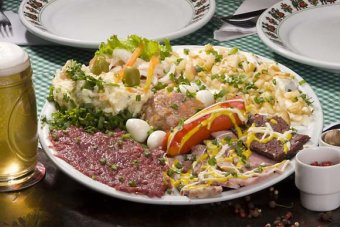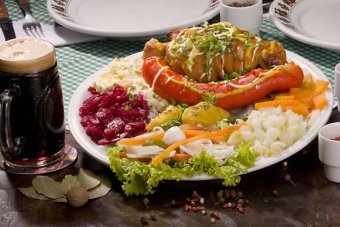HOJE VOU FALAR UM POUCO DA CULTURA GERMÂNICA. EM HOMENAGEM AOS MEUS BISAVÓS MATERNOS E A MINHA BISAVÓ PATERNA.
Today I will talk a bit about German culture. IN TRIBUTE TO MYAND MY great-grandmother great-grandmother.
Today I will talk a bit about German culture. IN TRIBUTE TO MYAND MY great-grandmother great-grandmother.
BISAVÓS MATERNOS.
Maternal great-grandmother.
MEU TIO ROBER FRANCISCO, NO BEIRA RIO, ESTÁDIO DO SPORT CLUB INTERNACIONAL.
MY UNCLE Robert Francisco, Riverside, SPORT STADIUMCLUB INTERNATIONAL.
EU, A MAIS OU MENOS 9 OU 10 ANOS ATRÁS, NO CAÍS DO PORTO, PORTO ALEGRE. COM CABELOS ALISADOS E BEM LOIRINHA. AH... GORDINHA, SEMPRE!
ALGUMAS FOTOS NÃO ESTÃO MUITO LEGAIS PORQUE TIREI FOTO DA FOTO, MUITO ANTIGA E NA ÉPOCA NÃO ERA DIGITAL.
U.S., to about 9 or 10 years ago, in the harbor of Porto Alegre.AND WELL WITH straightened hair Blonde. AH ... Fat, EVER!
SOME PHOTOS ARE NOT VERY LEGAL because I tookPHOTO PHOTO, AND VERY OLD AT THE TIME WAS NOTDIGITAL.
SOME PHOTOS ARE NOT VERY LEGAL because I tookPHOTO PHOTO, AND VERY OLD AT THE TIME WAS NOTDIGITAL.
Imigração alemã no Brasil
Origem: Wikipédia, a enciclopédia livre.
A imigração alemã no Brasil foi o movimento migratório ocorrido nos séculos XIX eXX de alemães para várias regiões do Brasil. As causas deste processo podem ser encontradas nos freqüentes problemas sociais que ocorriam na Europa e a fartura de terras no Brasil. Atualmente, estima-se que 5 milhões de brasileiros têm ao menos um antepassado alemão.[2]
Os alemães, atrás apenas dos italianos, formam a principal etnia no Sul do Brasil.[3]
A imigração durante o século XIX
[editar]Rio Grande do Sul
Em 1824 chegam os primeiros colonos alemães ao Rio Grande do Sul, sendo assentados na atual cidade de São Leopoldo. Os alemães chegavam em pequeno número todos os anos, porém eram em número suficiente para se organizar e expandir pela região.
Nos primeiros cinqüenta anos de imigração, foram introduzidos entre 20 e 28 mil alemães ao Rio Grande, a quase totalidade deles destinados à colonização agrícola. Os primeiros colonos vieram de Holstein, Hamburgo, Mecklemburgo eHannover. Depois, passaram a predominar os oriundos de Hunsrück e do Palatinado. Além desses, vieram da Pomerânia, Vestfália e deWürttemberg.[8]
Outras colônias foram criadas na sequência, como Três Forquilhas, Nova Petrópolis, Teutônia, Santa Cruz, São Lourenço, Colônia Santo Ângelo, Colônia de Santa Maria do Mundo Novo, etc.
German Immigration in Brazil
From Wikipedia, the free encyclopedia.
German immigration to Brazil was the migration occurred in the nineteenth EXX Germans for several regions of Brazil. The causes of this process can be found in the frequent social problems that occurred in Europe and plenty of land in Brazil.Currently, an estimated 5 million people have at least oneGerman ancestor. [2]
The Germans, behind the Italian, form the main ethnic group in southern Brazil. [3]
The immigration during the nineteenth century
[edit] New South Wales
Main article: German Settlement in Rio Grande do Sul
In 1824 the first German settlers arrive in Rio Grande do Sul,being seated in the current city of São Leopoldo. The Germansarrived in small numbers all year, but they were sufficient to organize and expand the region.
In the first fifty years of immigration were introduced between 20 and 28 000 Germans in Rio Grande, almost all of them intended for agricultural colonization. The first settlers came from Holstein,Hamburg, Mecklenburg eHannover. Then come to dominatethose from the Hunsrück and the Palatinate. Besides these,came from Pomerania, Westphalia and deWürttemberg. [8]
Other colonies were created in sequence, Three Forks, Nova Petrópolis, Teutonia, Santa Cruz, San Lorenzo, Colonia SantoAngelo, Colony of Saint Mary of the New World, etc..
From Wikipedia, the free encyclopedia.
German immigration to Brazil was the migration occurred in the nineteenth EXX Germans for several regions of Brazil. The causes of this process can be found in the frequent social problems that occurred in Europe and plenty of land in Brazil.Currently, an estimated 5 million people have at least oneGerman ancestor. [2]
The Germans, behind the Italian, form the main ethnic group in southern Brazil. [3]
The immigration during the nineteenth century
[edit] New South Wales
Main article: German Settlement in Rio Grande do Sul
In 1824 the first German settlers arrive in Rio Grande do Sul,being seated in the current city of São Leopoldo. The Germansarrived in small numbers all year, but they were sufficient to organize and expand the region.
In the first fifty years of immigration were introduced between 20 and 28 000 Germans in Rio Grande, almost all of them intended for agricultural colonization. The first settlers came from Holstein,Hamburg, Mecklenburg eHannover. Then come to dominatethose from the Hunsrück and the Palatinate. Besides these,came from Pomerania, Westphalia and deWürttemberg. [8]
Other colonies were created in sequence, Three Forks, Nova Petrópolis, Teutonia, Santa Cruz, San Lorenzo, Colonia SantoAngelo, Colony of Saint Mary of the New World, etc..
Em algumas décadas, a região do Vale do Rio dos Sinos estava quase que completamente ocupada por imigrantes alemães. A colonização transbordou da região, se expandindo por outras áreas do Rio Grande do Sul. É notável que a colonização alemã foi efetuada em terras baixas, seguindo o caminho dos rios. Na década de 1870, praticamente todas as terras baixas do interior do Rio Grande do Sul estavam sendo ocupadas pelos alemães, porém, as terras altas não atraíam os colonos, permanecendo desocupadas até a chegada dos italianos, em 1875.
In a few decades, the region of the River Valley of the Bells was almost completely occupied by German immigrants. The colonization of the flooded region, expanding into other areas of Rio Grande do Sul is remarkable that the German settlement was made in the lowlands, following the path of the rivers. In the 1870s, almost all the lowlands of the interior of Rio Grande do Sul were being occupied by the Germans, however, the highlands did not attract settlers, remained unoccupied until the arrival of the Italians in 1875.Oktoberfest celebration in the city of Rio Grande do Sul Igrejinha.
Park honoring the architecture of immigrants in Nova Petrópolis.
The beauty of the German cities of Brazil, such as grass, attracts thousands of tourists.
Estes são Fritz e Frida, Max e Milli, os personagens-símbolos da Oktoberfest. Eles representam a paixão pelas tradições germânicas trazidas pelos primeiros colonizadores, que chegaram à região há mais de 160 anos.
Eles representam a hospitalidade e a alegria que os visitantes encontam na Oktoberfest! Sejam bem-vindos!
These are Fritz and Frieda, Max and Milli, characters, symbols of the Oktoberfest. They represent the passion for the Germanic traditions brought by early settlers, who arrived in the region for over 160 years.
They represent the warmth and joy has returned to the visitors at the Oktoberfest! Welcome!

No domingo, antes da premiação, as pessoas puderam assistir à apresentação do Grupo de Tradição Gemânica, Baumschneis Wolkstanzqruppe, foi aí então, que se pode perceber, que a cidade de Dois Irmãos é duplamente abençoada, pois além de ter a Cultura Brasileira, também tem a cultura Germânica nas suas raízes.
On Sunday, before the award, people could attend thepresentation of Tradition Group Geman, BaumschneitzWolkstanzqruppe, there was then, that you can see, the city ofTwo Brothers is doubly blessed, because in addition to theBrazilian culture, also has its roots in German culture.
On Sunday, before the award, people could attend thepresentation of Tradition Group Geman, BaumschneitzWolkstanzqruppe, there was then, that you can see, the city ofTwo Brothers is doubly blessed, because in addition to theBrazilian culture, also has its roots in German culture.
Cultura germânica é exaltada na Oktoberfest de Blumenau.
German culture is exalted at the Oktoberfest in Blumenau.
Veja alguns pratos servidos no Bar do Alemão!
Here are a few dishes in the German Bar!
Conheça um pouco da cultura alemã no Largo da Ordem em CuritibaGerman culture is exalted at the Oktoberfest in Blumenau.
Veja alguns pratos servidos no Bar do Alemão!
Here are a few dishes in the German Bar!
Foto: Divulgação/Bar do Alemão









